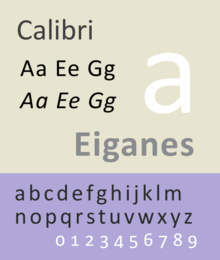
Back Calibri Catalan Calibri Czech Calibri German Calibri Spanish کالیبری Persian Calibri Finnish Calibri French Calibri ID Calibri (carattere) Italian Calibri Japanese
 | |
| Category | Sans-serif |
|---|---|
| Classification | Humanist[1] |
| Designer(s) | Luc(as) de Groot (Standard Latin, Cyrillic, Greek, and Hebrew); Mamoun Sakkal (Arabic); Ruben Tarumian (Armenian and Georgian)[2] |
| Foundry | Microsoft |
| Date created | 2002–2005 |
| Date released | 2007 |
| License | Proprietary |
| Metrically compatible with | Carlito |
Calibri (/kəˈliːbri/) is a digital sans-serif typeface family in the humanist or modern style. It was designed by Luc(as) de Groot in 2002–2004 and released to the general public in 2007, with Microsoft Office 2007 and Windows Vista.[3][4] In Office 2007, it replaced Times New Roman as the default typeface in Word[5] and replaced Arial as the default in PowerPoint, Excel, Outlook, and WordPad. De Groot described its subtly rounded design as having "a warm and soft character".[4] In January 2024, the font was replaced by Microsoft's new bespoke font, Aptos, as the new default Microsoft Office font, after 17 years.[6][7]
Calibri is part of the ClearType Font Collection, a suite of fonts from various designers released with Windows Vista.[8] All start with the letter C to reflect that they were designed to work well with Microsoft's ClearType text rendering system, a text rendering engine designed to make text clearer to read on liquid-crystal display monitors.[9] The other fonts in the same group are Cambria, Candara, Consolas, Constantia and Corbel.[4][10]
- ^ Berry, John D. (2004). Now Read This: the Microsoft ClearType Collection. Redmond, WA: Microsoft Corp.
- ^ "Calibri Font Family". Microsoft. Retrieved 8 October 2021.
- ^ Phinney, Thomas. "Calibri reached the general public on January 30, 2007, with the release of Microsoft Office 2007 and Windows Vista on that date". Quora. Retrieved 11 July 2017.
- ^ a b c Berry, John D.; De Groot, Lucas. "Case Study: Microsoft ClearType". Lucasfonts. Retrieved 11 July 2017.
- ^ "Microsoft typography: Calibri". Microsoft. Retrieved 10 December 2011.
- ^ Mather, Victor (28 February 2024). "Microsoft Word's Subtle Typeface Change Affected Millions. Did You Notice?". The New York Times. Archived from the original on 29 February 2024. Retrieved 11 March 2024.
- ^ "A change of typeface: Microsoft's new default font has arrived". Microsoft Design. Retrieved 11 March 2024.
- ^ "The Microsoft ClearType Font Collection". Microsoft Typography. Microsoft. Retrieved 31 August 2017.
- ^ Hudson, John. "Comments on Typophile thread". Typophile. Archived from the original on 30 October 2014. Retrieved 28 September 2014.
- ^ Cite error: The named reference
Van Wagenerwas invoked but never defined (see the help page).